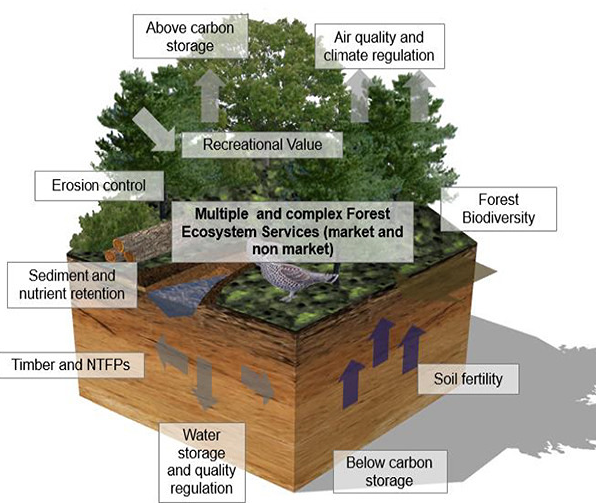Ecosystem Services

Ecosystem services are the benefits that humans derive from natural ecosystems, of which trees, woodlands and forests are a critical component. While these complex ecological systems ensure the physical survival and well-being of all living organisms, including ourselves, they are also vital for human well-being, public health and social stability. In 2021, the latest year with complete data, the total annual value for woodland ecosystem services in the UK was £10.4 billion (2022 prices). This is a partial valuation, excluding food from agroforestry and education, for example
Ecosystem Services can be considered in four categories:
1) Provisioning Services
Trees provide a variety of direct products that are essential for human survival and well-being, including:
Food: Trees offer fruits, nuts, and seeds (e.g., apples, oranges, almonds), which are key food sources for both humans and animals.
Fuel: Wood from trees is still widely used as fuel for cooking and heating.
Timber and Wood Products: Trees provide raw materials like timber for construction, paper, and furniture.
Medicinal Resources: Many trees produce compounds used in traditional and modern medicine, including salicylic acid, the basis for aspirin which was originally derived from the bark of the willow tree.
2) Regulating Services
Trees are crucial for regulating ecological processes, contributing to environmental stability and resilience:
Climate Regulation: Trees absorb carbon dioxide (CO₂) from the atmosphere through photosynthesis, acting as carbon sinks and helping to mitigate climate change. Forests and tree cover also influence local climates by moderating temperatures and increasing humidity.
Urban Heat Island Effect: Trees cool cities by providing shade and releasing water vapor through transpiration, reducing the heat island effect common in cities.
Noise Reduction: Tree canopies and foliage help dampen noise pollution, especially in urban areas.
Air Quality Improvement: Trees filter pollutants from the air, such as particulate matter, nitrogen oxides, and sulphur dioxide, improving overall air quality.
Water Regulation: Trees help regulate the water cycle by intercepting rainfall, reducing runoff, and promoting groundwater recharge. Forested areas play a key role in maintaining clean water supplies.
Soil Protection: Tree roots bind the soil, preventing erosion, landslides, and nutrient loss, especially on slopes and riverbanks.
Flood Control: Trees and forests absorb excess water during heavy rainfall, reducing the risk of floods.
Biodiversity Support: Trees provide habitats for a wide variety of species, from birds and insects to mammals, promoting biodiversity and ecosystem resilience.
3) Cultural Services
Trees have profound cultural, spiritual, and recreational value for people:
Aesthetic and Recreational Value: Forests, parks, and urban green spaces are valued for their beauty and tranquillity, offering spaces for activities like hiking, birdwatching, and relaxation.
Psychological Well-being: Green spaces with trees are linked to lower stress levels, better mental health, and increased productivity.
Spiritual and Religious Importance: Many cultures consider trees sacred and use them in spiritual rituals. Sacred groves and individual trees hold special significance in various religions.
Cultural Heritage: Trees are often symbols of cultural identity, represented in folklore, literature, and traditions. For example, the oak tree is a symbol of strength in many cultures.
Tourism: Trees attract ecotourism, as people visit forests, national parks, and wildlife reserves to experience nature and biodiversity.
4) Supporting Services
Trees play a fundamental role in the ecosystem processes that sustain life on Earth:
Soil Formation: The decomposition of leaves and organic matter from trees enriches the soil, contributing to its fertility and structure.
Nutrient Cycling: Trees are integral to nutrient cycling, especially in forest ecosystems. They absorb nutrients from the soil and, when they shed leaves or die, return these nutrients to the ground, promoting healthy ecosystems.
Primary Production: Trees convert sunlight into energy through photosynthesis, forming the base of many food chains and supporting life for herbivores and other organisms.
Biodiversity Habitat: Trees provide complex habitats that support diverse forms of life, contributing to ecosystem stability and species richness.
